仁爱版八年级英语下册Unit 8 Our Clothes Topic 3 He said the fashion show was wonderful. 知识点复习课件(共22张PPT)
文档属性
| 名称 | 仁爱版八年级英语下册Unit 8 Our Clothes Topic 3 He said the fashion show was wonderful. 知识点复习课件(共22张PPT) | 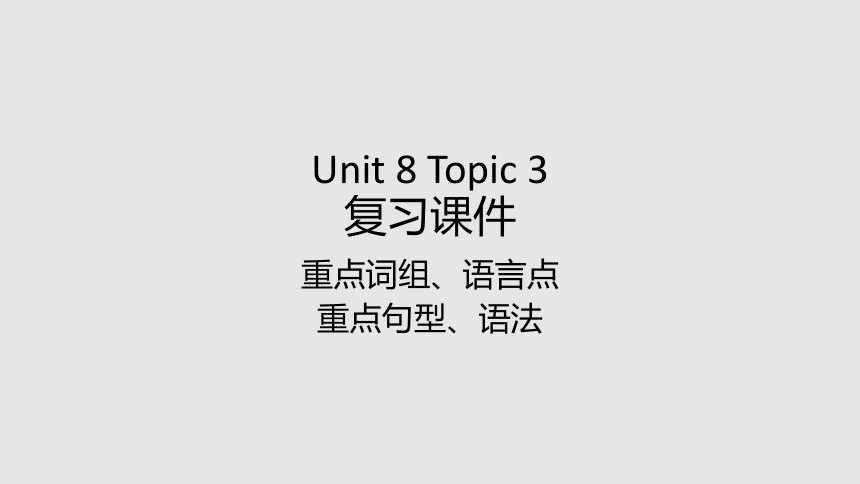 | |
| 格式 | zip | ||
| 文件大小 | 94.4KB | ||
| 资源类型 | 教案 | ||
| 版本资源 | 仁爱科普版 | ||
| 科目 | 英语 | ||
| 更新时间 | 2020-04-12 15:11:47 | ||
图片预览

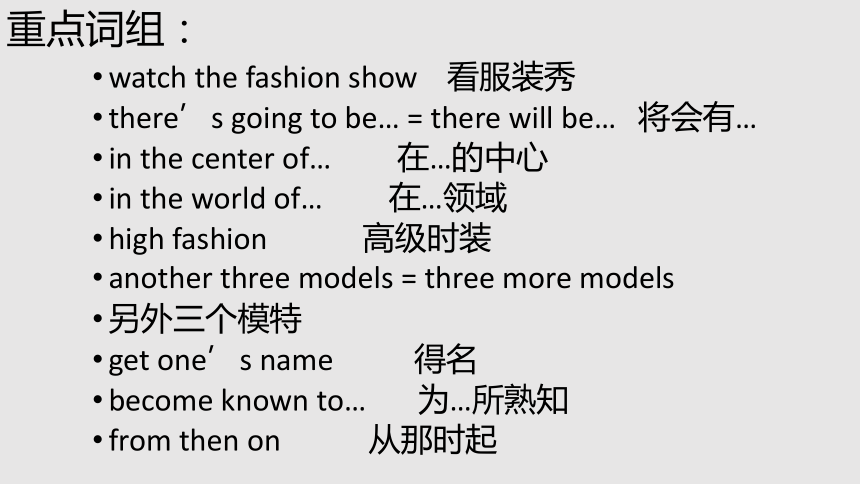
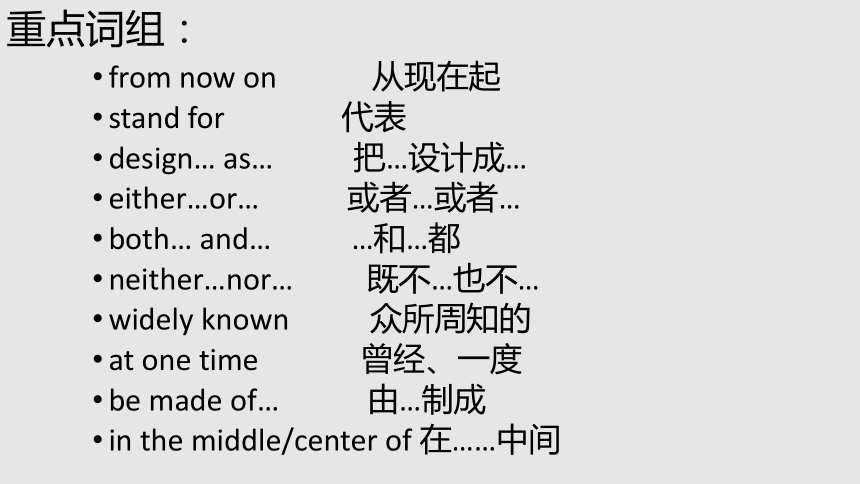
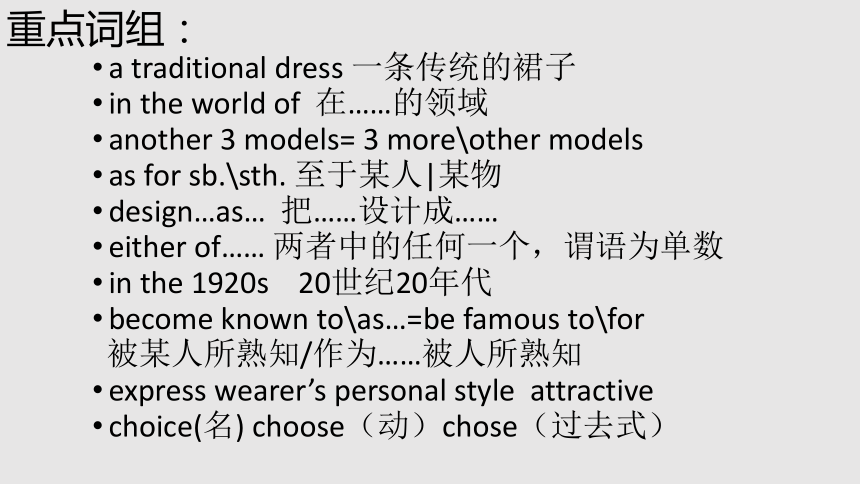
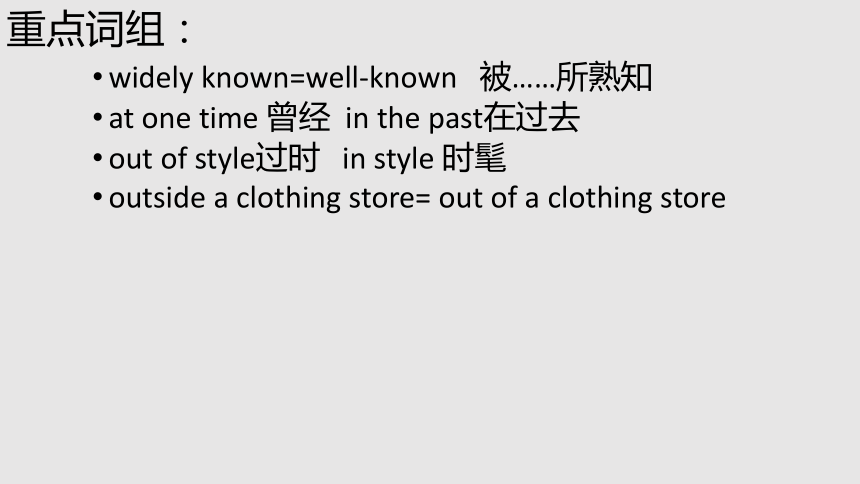
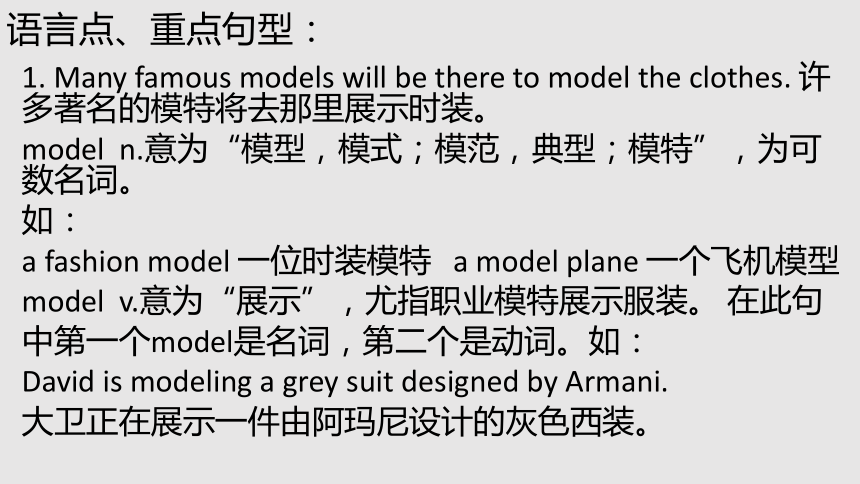
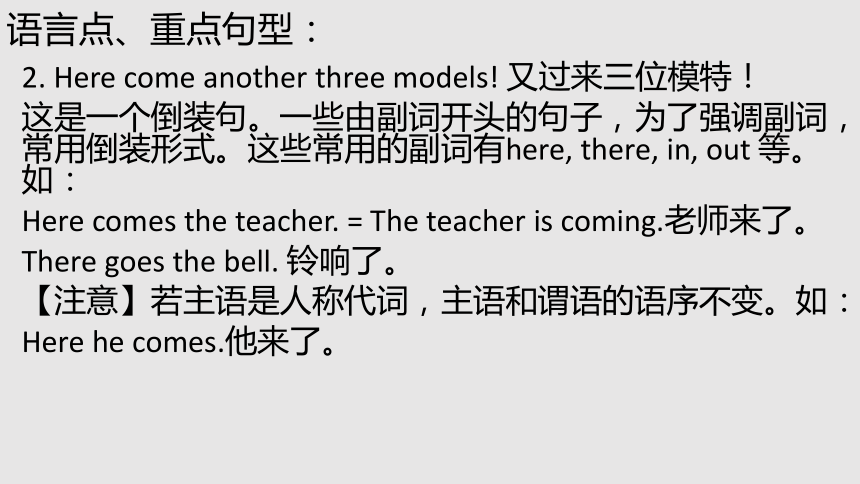
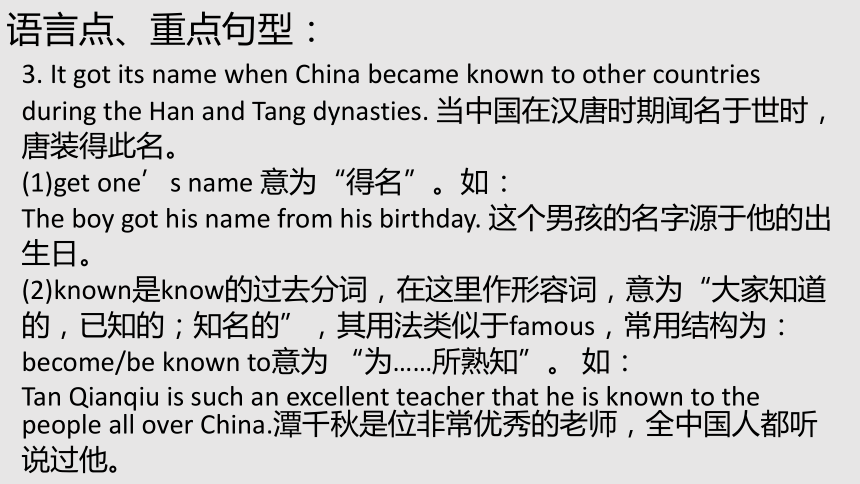
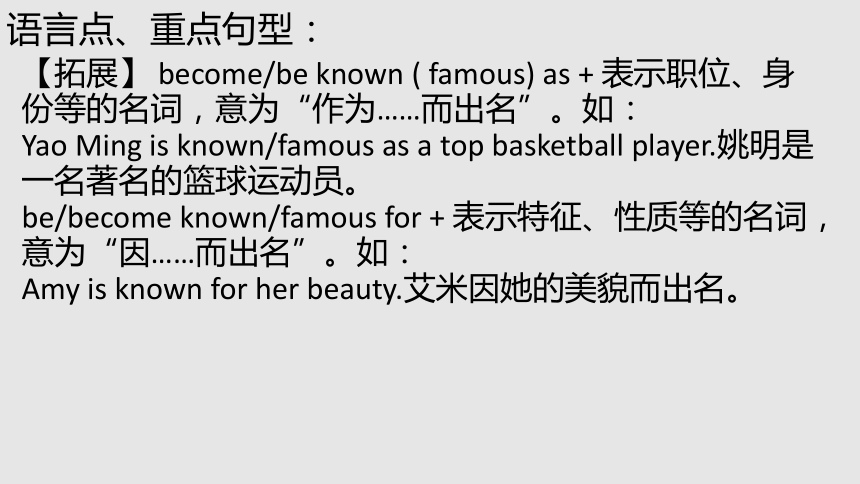
文档简介
(共22张PPT)
Unit 8 Topic 3
复习课件
重点词组、语言点
重点句型、语法
重点词组:
watch the fashion show 看服装秀
there’s going to be… = there will be… 将会有…
in the center of… 在…的中心
in the world of… 在…领域
high fashion 高级时装
another three models = three more models
另外三个模特
get one’s name 得名
become known to… 为…所熟知
from then on 从那时起
重点词组:
from now on 从现在起
stand for 代表
design… as… 把…设计成…
either…or… 或者…或者…
both… and… …和…都
neither…nor… 既不…也不…
widely known 众所周知的
at one time 曾经、一度
be made of… 由…制成
in the middle/center of 在……中间
重点词组:
a traditional dress 一条传统的裙子
in the world of 在……的领域
another 3 models= 3 more\other models
as for sb.\sth. 至于某人|某物
design…as… 把……设计成……
either of…… 两者中的任何一个,谓语为单数
in the 1920s 20世纪20年代
become known to\as…=be famous to\for
被某人所熟知/作为……被人所熟知
express wearer’s personal style attractive
choice(名) choose(动)chose(过去式)
重点词组:
widely known=well-known 被……所熟知
at one time 曾经 in the past在过去
out of style过时 in style 时髦
outside a clothing store= out of a clothing store
1. Many famous models will be there to model the clothes. 许多著名的模特将去那里展示时装。
model n.意为“模型,模式;模范,典型;模特”,为可数名词。
如:
a fashion model 一位时装模特 a model plane 一个飞机模型
model v.意为“展示”,尤指职业模特展示服装。 在此句
中第一个model是名词,第二个是动词。如:
David is modeling a grey suit designed by Armani.
大卫正在展示一件由阿玛尼设计的灰色西装。
语言点、重点句型:
2. Here come another three models! 又过来三位模特!
这是一个倒装句。一些由副词开头的句子,为了强调副词,常用倒装形式。这些常用的副词有here, there, in, out 等。如:
Here comes the teacher. = The teacher is coming.老师来了。
There goes the bell. 铃响了。
【注意】若主语是人称代词,主语和谓语的语序不变。如:
Here he comes.他来了。
语言点、重点句型:
3. It got its name when China became known to other countries
during the Han and Tang dynasties. 当中国在汉唐时期闻名于世时,
唐装得此名。
(1)get one’s name 意为“得名”。如:
The boy got his name from his birthday. 这个男孩的名字源于他的出
生日。
(2)known是know的过去分词,在这里作形容词,意为“大家知道
的,已知的;知名的”,其用法类似于famous,常用结构为:
become/be known to意为 “为……所熟知”。 如:
Tan Qianqiu is such an excellent teacher that he is known to the people all over China.潭千秋是位非常优秀的老师,全中国人都听
说过他。
语言点、重点句型:
【拓展】 become/be known ( famous) as + 表示职位、身
份等的名词,意为“作为……而出名”。如:
Yao Ming is known/famous as a top basketball player.姚明是
一名著名的篮球运动员。
be/become known/famous for + 表示特征、性质等的名词,
意为“因……而出名”。如:
Amy is known for her beauty.艾米因她的美貌而出名。
语言点、重点句型:
语言点、重点句型:
4. Today people can design the Tang costume as either formal
or casual clothes.现在人们既可以把唐装设计成正装,也可
以设计成休闲装。
either ... or…表选择关系,意为“要么……要么……”,
“不是……就是……”。如:
You may come either on Sunday or on Friday.
你可以星期天或者星期五来。
另外,either ... or ...连接两个主语时,谓语动词要和or后面
的主语保持一致,遵循就近原则。如:
Either Mr. Zhang or his students are coming here.
Either his students or Mr. Zhang is coming here.
要么张老师来,要么他的学生来。
5. The well-known item of American clothing is blue jeans.最
著名的美国服装是蓝色牛仔裤。
well known与widely known意思相近,意为“众所周知,广
为人知;有名的,著名的”。如:
They are well-known in the world. 他们在世界上很有名。
【拓展】widely是副词,修饰known,意为“广泛地”,它
的形容词形式是wide。如:
English is widely used in China. 英语在中国被广泛应用。
The road is about 5 meters wide.那条路大约5米宽。
语言点、重点句型:
6. At one time, Japanese people wore kimonos for casual and
formal occasions.曾经,日本人在正式和非正式场合都穿和
服。
at one time意为“曾经,过去有段时间”,用于一般过去
时。如:
At one time, we met every day. 过去有段时间,我们天天见
面。
【链接】at times意为“有时”,相当于 sometimes,可用于
一般过去时或一般现在时。如:
We have pies for dinner at times.我们有时晚餐吃馅饼。
语言点、重点句型:
【拓展】at a time意为“一次,每一次”,一般放于句末。
如:
He spoke half an hour at a time.他一次讲半小时。
7. Today, few people wear kimonos except on special
occasions like marriages and national celebrations. 现在除了
一些特殊场合,像婚礼和国家庆典外,几乎没人穿和服。
(1) few adj.意为“很少,几乎没有”,含有否定含义。如:
Few people went there.几乎没人去那儿。
语言点、重点句型:
(2) except意为“除去”,指除去与整体所述情况不同的部
分,是减的概念。其后可接名词、代词、不定式或介词短
语等,一般不放在句首。如:
There will be rain everywhere except the south. 除了南方,
各处均有雨。
【辨析】except for, besides, but
①except for用来引出一个相反的理由和细节,修饰前面所
说的情况。如:
Your composition is excellent except for a few spelling
mistakes. 你的作文写得很好,只是有些拼写错误。
语言点、重点句型:
②besides既可作介词,也可作副词。意为 “除……之外,
还有”,是加的概念。如:
There are fifty-five minorities in China besides the Han.中国除
汉族外,还有五十五个少数民族。
I don’t know the answer. Besides, I don’t come here to
answer questions.我不知道答案,况且我到这儿来不是回答
问题的。
③but也有“除去……以外”的意思。多用在all, no,
anywhere, everywhere, nobody 等后面。如:
There is nobody but her.除她之外没有人了。
语言点、重点句型:
8. When it became popular: in the 1920s. 流行时间:20世纪
20年代。
in the 1920s意为“在20世纪20年代”。
如: in the 1760s在18世纪60年代
The dance was popular in the 1950s.
这种舞蹈流行于20世纪50年代。
语言点、重点句型:
重点语法:宾语从句
【速记口诀】
宾语从句须注意,几点事项应牢记。
一是关键引导词,不同句子词相异。陈述句子用that;一般疑问是否(if,whether)替;特殊问句更好办,引导还用疑问词。
二是时态常变化,主句不同从句异。主句若为现在时,从句时态应看意;主句若为过去时,从句时态向前移。
三是语序要记清,从句永保陈述序
【妙语诠释】
宾语从句应注意三点:
①引导词,陈述句一般由that引导,这时的that可以省略;一般疑问句则由if或whether引导;而特殊疑问句则由特殊疑问词引导。
②时态,主句是现在时态,从句可用所需要的任何时态;但如果主句是过去时态,从句时态所表示时间一般往前移一个时间段。
③语序,宾语从句永远要用陈述句顺序。
重点语法:宾语从句
宾语从句的时态
1. 如果主句的时态是一般现在时,宾语从句该用什么时态就用什么时态。即,从句可用所需的任何时态
如:
I don’t think (that) you are right.
Please tell us where he is.
Can you tell me how I can get to the railway station?
He says Mary is playing with the cat .
He says Mary often plays with the cat.
He says Mary will play with the cat.
I think he left yesterday morning.
重点语法:宾语从句
2. 如果主句的时态是一般过去时,宾语从句只能用相应的过去时态(一般过去时, 过去进行时, 过去将来时,过去完成时)。例如:
He asked what time it was.
He told me that he was preparing for the sports meet.
He asked if you had written to Peter.
He said that he would go back to the U.S. soon.
He said, “Mary is playing with the cat.” →
He said Mary was playing with the cat.
He said, “he will go back to China soon.” →
He said he would go back to China soon
重点语法:宾语从句
3. 如果宾语从句所陈述的是客观真理,其时态常用一般现在时,不受主句时态的限制。例如:
Our teacher said that January is the first month of the year.
Scientists have proved that the earth turns around the sun.
The teacher said, “the moon moves around the sun.”
→ The teacher said that the moon moves around the sun.
He said, “light travels much faster than sound.”
→ He said light travels much faster than sound.
重点语法:宾语从句
4、当主句为 Could you (please) tell us-----?时,只表示语气,而不表示过去时态。
?考点归纳——宾语从句的时态
?1、当主句动词为一般现在时,从句可用所需的任何时态。
?2、当主句动词为一般过去时,宾语从句只能用相应的过去时态(一般过去时、过去进行时、过去将来时、过去完成时)。
?3、当宾语从句为客观真理时 ,用一般现在时态,不受主句时态的限制。
4、当主句为 Could you (please) tell us-----?时,只表示语气,而不表示过去时态。
重点语法:宾语从句
Unit 8 Topic 3
复习课件
重点词组、语言点
重点句型、语法
重点词组:
watch the fashion show 看服装秀
there’s going to be… = there will be… 将会有…
in the center of… 在…的中心
in the world of… 在…领域
high fashion 高级时装
another three models = three more models
另外三个模特
get one’s name 得名
become known to… 为…所熟知
from then on 从那时起
重点词组:
from now on 从现在起
stand for 代表
design… as… 把…设计成…
either…or… 或者…或者…
both… and… …和…都
neither…nor… 既不…也不…
widely known 众所周知的
at one time 曾经、一度
be made of… 由…制成
in the middle/center of 在……中间
重点词组:
a traditional dress 一条传统的裙子
in the world of 在……的领域
another 3 models= 3 more\other models
as for sb.\sth. 至于某人|某物
design…as… 把……设计成……
either of…… 两者中的任何一个,谓语为单数
in the 1920s 20世纪20年代
become known to\as…=be famous to\for
被某人所熟知/作为……被人所熟知
express wearer’s personal style attractive
choice(名) choose(动)chose(过去式)
重点词组:
widely known=well-known 被……所熟知
at one time 曾经 in the past在过去
out of style过时 in style 时髦
outside a clothing store= out of a clothing store
1. Many famous models will be there to model the clothes. 许多著名的模特将去那里展示时装。
model n.意为“模型,模式;模范,典型;模特”,为可数名词。
如:
a fashion model 一位时装模特 a model plane 一个飞机模型
model v.意为“展示”,尤指职业模特展示服装。 在此句
中第一个model是名词,第二个是动词。如:
David is modeling a grey suit designed by Armani.
大卫正在展示一件由阿玛尼设计的灰色西装。
语言点、重点句型:
2. Here come another three models! 又过来三位模特!
这是一个倒装句。一些由副词开头的句子,为了强调副词,常用倒装形式。这些常用的副词有here, there, in, out 等。如:
Here comes the teacher. = The teacher is coming.老师来了。
There goes the bell. 铃响了。
【注意】若主语是人称代词,主语和谓语的语序不变。如:
Here he comes.他来了。
语言点、重点句型:
3. It got its name when China became known to other countries
during the Han and Tang dynasties. 当中国在汉唐时期闻名于世时,
唐装得此名。
(1)get one’s name 意为“得名”。如:
The boy got his name from his birthday. 这个男孩的名字源于他的出
生日。
(2)known是know的过去分词,在这里作形容词,意为“大家知道
的,已知的;知名的”,其用法类似于famous,常用结构为:
become/be known to意为 “为……所熟知”。 如:
Tan Qianqiu is such an excellent teacher that he is known to the people all over China.潭千秋是位非常优秀的老师,全中国人都听
说过他。
语言点、重点句型:
【拓展】 become/be known ( famous) as + 表示职位、身
份等的名词,意为“作为……而出名”。如:
Yao Ming is known/famous as a top basketball player.姚明是
一名著名的篮球运动员。
be/become known/famous for + 表示特征、性质等的名词,
意为“因……而出名”。如:
Amy is known for her beauty.艾米因她的美貌而出名。
语言点、重点句型:
语言点、重点句型:
4. Today people can design the Tang costume as either formal
or casual clothes.现在人们既可以把唐装设计成正装,也可
以设计成休闲装。
either ... or…表选择关系,意为“要么……要么……”,
“不是……就是……”。如:
You may come either on Sunday or on Friday.
你可以星期天或者星期五来。
另外,either ... or ...连接两个主语时,谓语动词要和or后面
的主语保持一致,遵循就近原则。如:
Either Mr. Zhang or his students are coming here.
Either his students or Mr. Zhang is coming here.
要么张老师来,要么他的学生来。
5. The well-known item of American clothing is blue jeans.最
著名的美国服装是蓝色牛仔裤。
well known与widely known意思相近,意为“众所周知,广
为人知;有名的,著名的”。如:
They are well-known in the world. 他们在世界上很有名。
【拓展】widely是副词,修饰known,意为“广泛地”,它
的形容词形式是wide。如:
English is widely used in China. 英语在中国被广泛应用。
The road is about 5 meters wide.那条路大约5米宽。
语言点、重点句型:
6. At one time, Japanese people wore kimonos for casual and
formal occasions.曾经,日本人在正式和非正式场合都穿和
服。
at one time意为“曾经,过去有段时间”,用于一般过去
时。如:
At one time, we met every day. 过去有段时间,我们天天见
面。
【链接】at times意为“有时”,相当于 sometimes,可用于
一般过去时或一般现在时。如:
We have pies for dinner at times.我们有时晚餐吃馅饼。
语言点、重点句型:
【拓展】at a time意为“一次,每一次”,一般放于句末。
如:
He spoke half an hour at a time.他一次讲半小时。
7. Today, few people wear kimonos except on special
occasions like marriages and national celebrations. 现在除了
一些特殊场合,像婚礼和国家庆典外,几乎没人穿和服。
(1) few adj.意为“很少,几乎没有”,含有否定含义。如:
Few people went there.几乎没人去那儿。
语言点、重点句型:
(2) except意为“除去”,指除去与整体所述情况不同的部
分,是减的概念。其后可接名词、代词、不定式或介词短
语等,一般不放在句首。如:
There will be rain everywhere except the south. 除了南方,
各处均有雨。
【辨析】except for, besides, but
①except for用来引出一个相反的理由和细节,修饰前面所
说的情况。如:
Your composition is excellent except for a few spelling
mistakes. 你的作文写得很好,只是有些拼写错误。
语言点、重点句型:
②besides既可作介词,也可作副词。意为 “除……之外,
还有”,是加的概念。如:
There are fifty-five minorities in China besides the Han.中国除
汉族外,还有五十五个少数民族。
I don’t know the answer. Besides, I don’t come here to
answer questions.我不知道答案,况且我到这儿来不是回答
问题的。
③but也有“除去……以外”的意思。多用在all, no,
anywhere, everywhere, nobody 等后面。如:
There is nobody but her.除她之外没有人了。
语言点、重点句型:
8. When it became popular: in the 1920s. 流行时间:20世纪
20年代。
in the 1920s意为“在20世纪20年代”。
如: in the 1760s在18世纪60年代
The dance was popular in the 1950s.
这种舞蹈流行于20世纪50年代。
语言点、重点句型:
重点语法:宾语从句
【速记口诀】
宾语从句须注意,几点事项应牢记。
一是关键引导词,不同句子词相异。陈述句子用that;一般疑问是否(if,whether)替;特殊问句更好办,引导还用疑问词。
二是时态常变化,主句不同从句异。主句若为现在时,从句时态应看意;主句若为过去时,从句时态向前移。
三是语序要记清,从句永保陈述序
【妙语诠释】
宾语从句应注意三点:
①引导词,陈述句一般由that引导,这时的that可以省略;一般疑问句则由if或whether引导;而特殊疑问句则由特殊疑问词引导。
②时态,主句是现在时态,从句可用所需要的任何时态;但如果主句是过去时态,从句时态所表示时间一般往前移一个时间段。
③语序,宾语从句永远要用陈述句顺序。
重点语法:宾语从句
宾语从句的时态
1. 如果主句的时态是一般现在时,宾语从句该用什么时态就用什么时态。即,从句可用所需的任何时态
如:
I don’t think (that) you are right.
Please tell us where he is.
Can you tell me how I can get to the railway station?
He says Mary is playing with the cat .
He says Mary often plays with the cat.
He says Mary will play with the cat.
I think he left yesterday morning.
重点语法:宾语从句
2. 如果主句的时态是一般过去时,宾语从句只能用相应的过去时态(一般过去时, 过去进行时, 过去将来时,过去完成时)。例如:
He asked what time it was.
He told me that he was preparing for the sports meet.
He asked if you had written to Peter.
He said that he would go back to the U.S. soon.
He said, “Mary is playing with the cat.” →
He said Mary was playing with the cat.
He said, “he will go back to China soon.” →
He said he would go back to China soon
重点语法:宾语从句
3. 如果宾语从句所陈述的是客观真理,其时态常用一般现在时,不受主句时态的限制。例如:
Our teacher said that January is the first month of the year.
Scientists have proved that the earth turns around the sun.
The teacher said, “the moon moves around the sun.”
→ The teacher said that the moon moves around the sun.
He said, “light travels much faster than sound.”
→ He said light travels much faster than sound.
重点语法:宾语从句
4、当主句为 Could you (please) tell us-----?时,只表示语气,而不表示过去时态。
?考点归纳——宾语从句的时态
?1、当主句动词为一般现在时,从句可用所需的任何时态。
?2、当主句动词为一般过去时,宾语从句只能用相应的过去时态(一般过去时、过去进行时、过去将来时、过去完成时)。
?3、当宾语从句为客观真理时 ,用一般现在时态,不受主句时态的限制。
4、当主句为 Could you (please) tell us-----?时,只表示语气,而不表示过去时态。
重点语法:宾语从句
同课章节目录
- Unit 5 Feeling excited
- Topic 1 You look excited
- Topic 2 I’m feeling better now.
- Topic 3 Many things can affect our feelings.
- Unit 6 Enjoying Cycling
- Topic 1 We're going on a three-day visit to Mount
- Topic 2 How about exploring Tian’anmen Square?
- Topic 3 Bicycle riding is good exercise.
- Unit 7 Food festival
- Topic 1 We’re preparing for a food festival.
- Topic 2 I’m not sure whether I can cook it well.
- Topic 3 I Cooked the Most Successfully
- Unit 8 Our Clothes
- Topic 1 We will have a class fashion show.
- Topic 2 We can design our own uniforms.
- Topic 3 He said the fashion show was wonderful.
